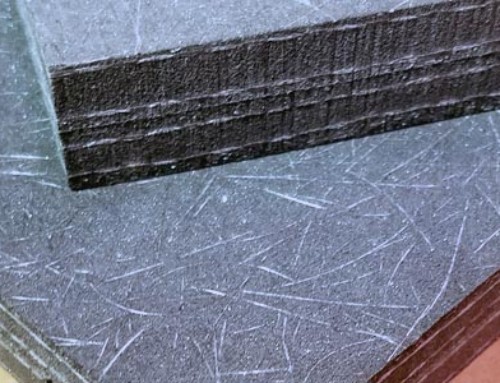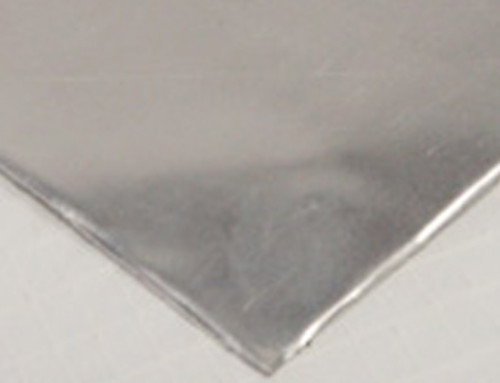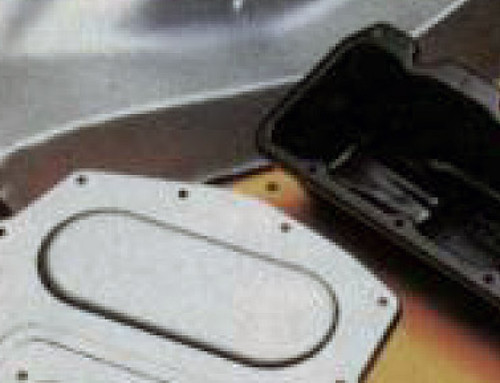Replacing normal plywood with Noiseless Wood improves the transmission loss in two critical regions. First: at the resonance frequencies of the structure the peak vibration levels are reduced about 10 fold. Second: at mid to high frequencies there is a phenomenon referred to as the coincidence frequency. This is the sound that has the same wavelength in air, as does the bending wave in the panel at the same frequency.

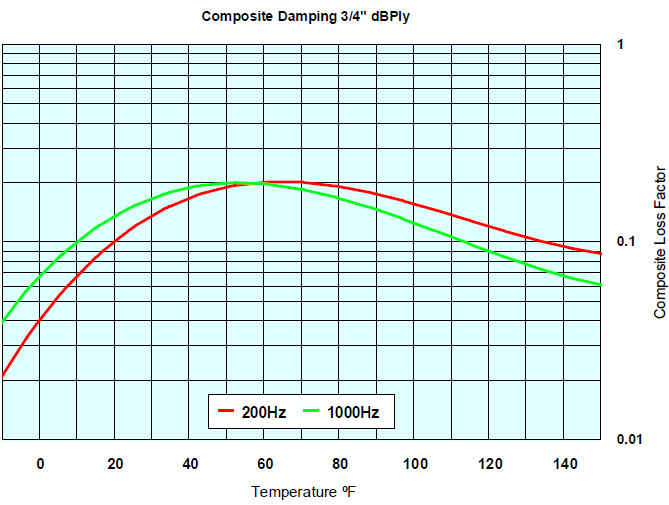
Figure 1 – Noiseless Wood Damping Loss Factors are at least 10 times higher than Normal Plywood
Vibration Damping
Typical resonance vibration damping measurements were made using a free-free beam 24” long by 2” wide ¾” thick. The beams were supported in the center on an impedance head in a temperature controlled climate chamber. The average composite loss factors for ACQ and XL Noiseless Wood are shown in Fig.1. ACQ plywood with identical dimensions had a composite loss factor of approximately 0.02 at all temperatures.
The damping effect is more efficient in the cross grain direction of the ply laminate because the system is less stiff in this direction, (see figure 5) and the VEL25 damping layer is better able to reduce the resonant vibrations. However the damping efficiency is so high, that Noiseless Wood will reduce all modes of vibration in any direction over a broad temperature and frequency range.
Reduction in Radiated Sound
Reduction of the peak levels of vibration will have a considerable effect on the radiated sound levels. When wood-based construction materials are laminated with VEL 25 to form Noiseless Wood, the resonant vibrations are reduced considerably. Figure 2 shows the amplitudes of the resonant frequencies are 10 to 20dB higher with AB Marine than those of the Noiseless Wood.
Plywood is chosen as a construction material for its lightweight and high strength. This gives it a handicap when it is also used as a noise barrier as its low inertia and low internal damping allows sound to pass through it with relative ease.
This high strength to weight ratio makes plywood a very efficient radiator of sound, hence its use in the construction of musical instruments. Increasing the damping by using Noiseless Wood, then makes the material couple less efficiently with the surrounding air as well as reducing the peak levels at resonance.
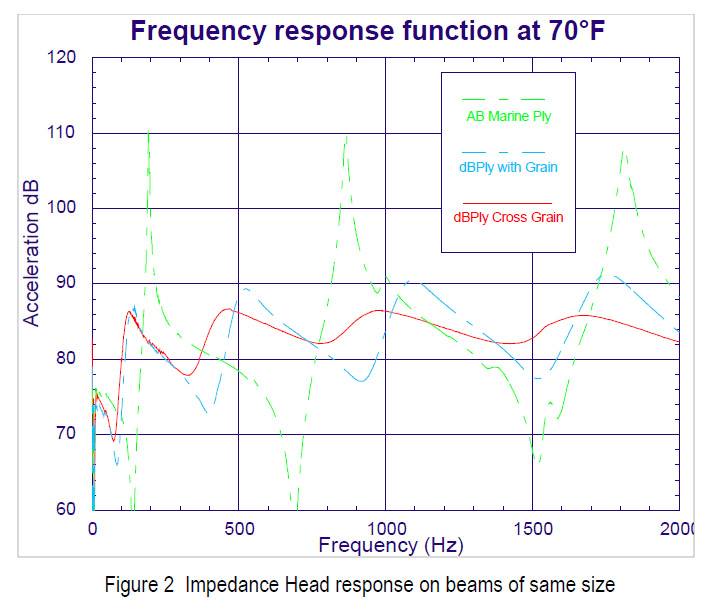
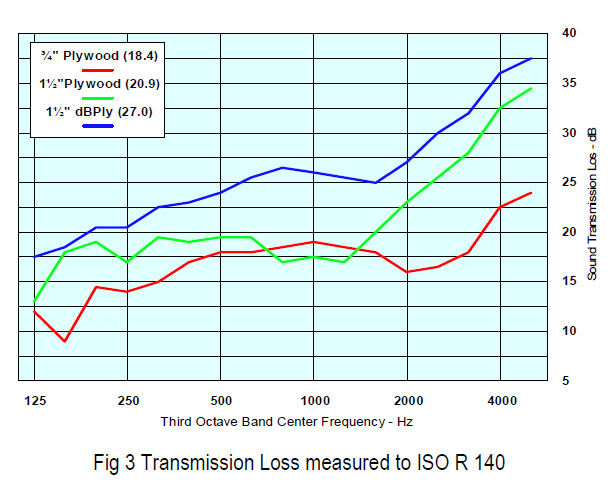
Sound Transmission
Replacing normal plywood with Noiseless Wood improves the transmission loss in two critical regions. First: at the resonance frequencies of the structure the peak vibration levels are reduced about ten fold. Second: at mid to high frequencies there is a phenomenon referred to as the coincidence frequency. This is the sound that has the same wavelength in air, as does the bending wave in the panel at the same frequency. This wavelength matching reduces the sound transmission blocking effect of the panel severely. Unfortunately for typical plywood structures, this coincidence frequency occurs at about 1000Hz, which is also the frequency at which most engines have a maximum output of acoustical energy. Noiseless Wood through its efficient damping of bending waves, effectively removes any loss to the sound barrier performance of the panel.
Example
Two enclosures were constructed for 300 HP, engine dynamometer. Plywood panels were used for the exterior of one enclosure, and Noiseless Wood panels were used for the exterior of the other. Both enclosure frames were 2” x 4” construction and the enclosures were lined with the same amount of absorption material. The approximate size of the enclosures were 5’ x 6’ x 6’.
The graph Figure 4 shows the difference in sound pressure level measured by a microphone inside the enclosure near the center compared to a microphone outside, 8” from the rear side of the enclosure. Similar curves were obtained for other engine speeds.
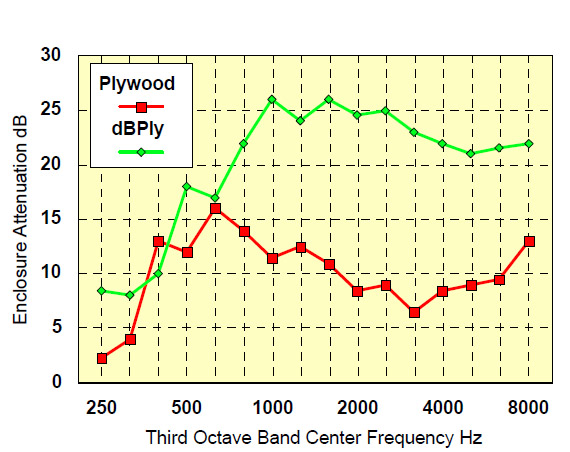
Fig 4 Improvement measured on a Dynamometer enclosure at 1000 rpm

Bending Stiffness
The dynamic stiffness is reduced when Noiseless Wood is used instead of normal plywood. This has the effect of changing the resonant frequencies (as seen in Figure 2 above) to a lower pitch as well as reducing the amplitude. In terms of sound quality Noiseless Wood gives the sound a note of superior quality as the bass tones become louder than the treble tones: Constructions with strong bass tone sound better than those with a tinny high-pitched response.
In the case where the design is critical for stiffness at elevated temperatures, the thickness of the Noiseless Wood system can be increased by 50%. The effective panel stiffness will then be maintained at elevated temperatures and exceeded at normal to low temperatures because the bending stiffness is controlled by the cubic power of the panel’s thickness.


